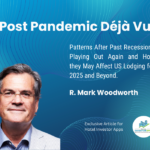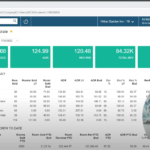R. Mark Woodworth, Principal of R.M. Woodworth & Associates and Board Member of Hotel Investor Apps Inc., brings over 40 years of hospitality industry advisory experience, including at CBRE Hotels and PKF Consulting, to inform his perspective on the current economic outlook for the U.S. lodging industry in this exclusive Hotel Investor Apps article.
2023 Economic Outlook for the US Hotel Industry
by R. Mark Woodworth
To quote a well-known song: “I read the news today, oh boy!” The Wall Street Journal reported that U.S. retail sales fell 1.1% in December, the biggest monthly decline of 2022 as consumers cut back, particularly since that month represents the height of holiday season. Hotel rooms rentals are a form of retail sales, and the majority of guest purchases may be considered discretionary in nature – paid for with disposable income.
Impact of Disposable Income
According to a report from IBIS World, per capita disposable income levels initially declined in 2020 as a result of the COVID-19 governmental response. Accommodative fiscal policy resulted in disposable income increasing 5.8% over the year. As soon as restrictive travel policies began to abate, a surge of “revenge travel” surfaced. The overall recovery has been somewhat sporadic, with disposable income increasing as much as 28.2% in March 2021, while decreasing as much as 10.1% in January 2022.
To fight surging inflation, the Federal Reserve began to aggressively raise benchmark interest rates throughout 2022, and tighter budgets and decreased disposable income have resulted. Once the various government stimulus programs were terminated, per capita disposable income actually decreased by 7.8% during the year.
Because of a resilient job market, IBIS World anticipates that per capita disposable income will begin to increase slowly in 2023. Until a meaningful reduction in the rate of inflation eases, the cost of living will continue to be high and disposable income levels will suffer. Per capita disposable income levels are only anticipated to rise 0.2% during the year.
US Lodging Forecast – Bearish or Bullish?
Thinking back over this past year, many important economic indicators (the rate of inflation, elevated energy costs, Federal Reserve rate increases, labor scarcity leading to higher wages, etc.) were suggesting that a recession in the near-to-mid-term bordered on being inevitable. Certainly, a bearish outlook.
What is the current expectation as we begin the New Year? What are the implications for the domestic lodging industry and is it time to stop “hugging the bear”? Or should one tighten their grip? Let’s start with the most recent lodging industry forecasts from the handful of firms known for such prognostications:
Select observations of these data include:
- All firms are forecasting an occupancy level for 2023 to remain well below the pre-pandemic 2019 level of 67.0 percent.
- The range in expectation for Average Daily Rate (ADR) growth in the year ahead is significant. The Kalibri Labs (KL) estimate of 1.6 percent is less than half of the aggregate average of the other four firms (4.0 percent). In a recent release from the firm, KL noted that the continuation of remote work impacted their forecast as it implies that transient corporate demand has been, and will continue to be, depressed. They did note, however, that an increased number of firms may want to bring their teams together, thus stimulating potential group demand. KL also notes that a considerable amount of overall group bookings “tend to be not quite as large and are more dispersed across different property types than they might have been historically.”
Reason for Optimism
What might be particularly noteworthy of the forecasts above is the expectation that all key performance indicators will be well above their 20-year annual Long Run Average. To varying degrees, each of these estimates may be considered “bullish” (certainly not “bearish”). This seems to be supported by our friends at Knowland, a provider of meetings-market intelligence.
Knowland expects 2023 to be the year that the industry surpasses 2019 meetings volume. They do note, however, some roadblocks remain: inflation, supplier staffing challenges and the threat of recession among them. Findings from the American Express Meetings & Events 2023 global forecast reveal that the stress level of meeting professionals is high – but for arguably a good reason: planners and suppliers are very busy which in turn has led to a great deal of confidence in the strength of business for 2023. American Express goes on to say that “for the most part, the “cautious optimism” of the previous two years has given way to full-on optimism”. Perhaps it is time to release the bear?
Also fueling a more optimistic outlook is the reduced levels of new construction expected in the years ahead. CBRE expects that “rising construction costs, a tight labor market, and high interest rates will serve to keep supply growth over the next five years to be 40 percent lower than historical trends.”
Back to the Economy
Despite signs that inflation has started to recede, economists still expect higher interest rates to push the U.S. economy into a recession in 2023, according to The Wall Street Journal’s latest quarterly survey. On average, business and academic economists polled by the Journal put the probability of a recession in the next 12 months at 61 percent, only slightly different from the 63 percent in October’s survey. Both figures are historically high outside actual recessions.
If there is good news among these data, the economists surveyed indicated that they expect any recession to be relatively shallow and short-lived. On average, they expect gross domestic product to increase at a 0.1 percent annual rate in the first quarter of 2023 and contract 0.4 percent in the second. They see no growth for the third quarter and a 0.6 percent growth rate for the fourth. In aggregate, economists expect GDP to be generally flat this year, posting growth of just 0.2 percent in the fourth quarter of 2023 compared with the fourth quarter of 2022. This is slightly down (i.e., more pessimistic) from the October 2022 WSJ survey in which economists forecast 0.4 percent GDP growth in 2023.
Overall, the signals are mixed, but hoping that the industry prognosticators are more right than wrong. As for me, I am not quite ready to release the bear.

Mark Woodworth, Principal of R.M. Woodworth & Associates and a Board Member of Hotel Investor Apps Inc., brings over 40 years of hospitality industry advisory experience, including at CBRE Hotels and PKF Consulting, to inform his perspective on the current economic outlook for the U.S. lodging industry.










